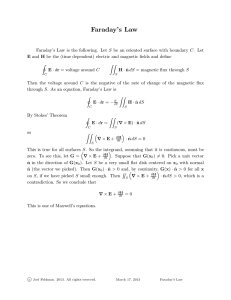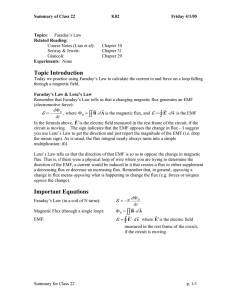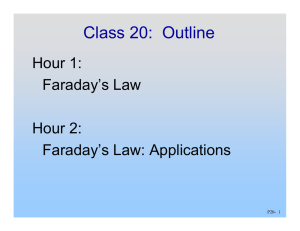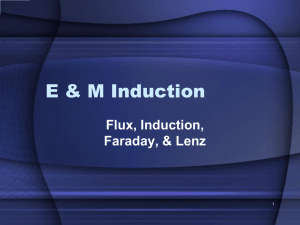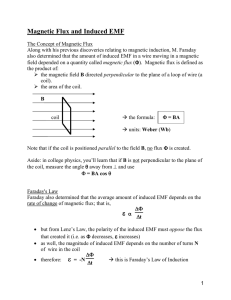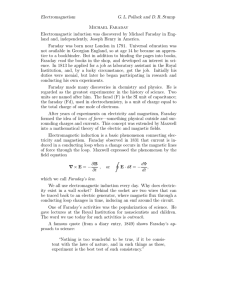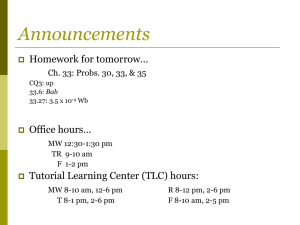Faraday Law PowerPoint
advertisement
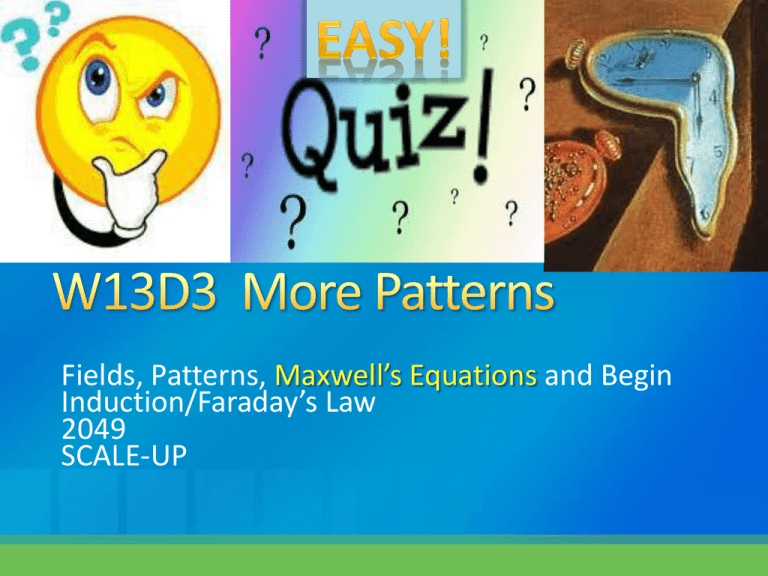
Fields, Patterns, Maxwell’s Equations and Begin Induction/Faraday’s Law 2049 SCALE-UP Monday 14 Wednesday Friday 16 (Read rest of 18 chapter) QUIZ Chapter 22 Lentz & More Chapter 22 Gauss 2 WebAssigns Chapter 22 Gauss 21 23 Chapter 23 Faraday QUIZ Chapter 23 Faraday 28 30 Chapter 23 Faraday Chapter 24 EM Saturday HOLIDAY 2 Chapter 24 EM Optional Exam (22-24) 3 FINAL EXAM THE EVAN SHOW Diverging Field Point Sources “Curly Field” No diverging source Electrostatic Fields Magnetic Fields q E ndA B • ndA 0 E dl ? =Faraday's Law of Induction - Next Topic B dl I (One additional term) inside 0 0 inside. path B d s i 0 enclosed Let’s apply this to the gap of a capacitor. i i CHARGING OR DISCHARGING …. HOW CAN CURRENT FLOW THROUGH THE GAP In a FIELD description?? I=0 T heELECT RICFLUX throughS2 E EA q 0 d E 1 dq dt 0 dt Let dq I d (in gap) dt Displacem ent Current dq d E Id 0 dt dt q E ndA B • ndA 0 E dl ? =Faraday's Law of Induction - Next Topic d B dl ( I + ) dt inside 0 E 0 inside. path 0 E dl ? =Faraday's Law of Induction - Galvanometer Coil Integral over a SURFACE A Observation Variables Direction Polarity Pitch Velocity Meter Deflects There must be an emf around the loops! Aluminum Pipe S N N REPEL!! Induced Current B Aluminum Pipe There must be an Electric Field in the metal that is pushing the current!! You said that there is a conducting loop. You said that there is therefore a current induced around the loop if the flux through the loop changes. But the beginning and end point of the loop are the same so how can there be a voltage difference around the loop? Or a current??? ‘tis a puzzlement! DID I LIE?? Electric fields that are created by static charges must start on a (+) charge and end on a (–) charge as I said previously. Electric Fields created by changing magnetic fields (NON-Coulombic) can actually be shaped in loops. STILL Because you said that an emf is a voltage so if I put a voltmeter from one point on the loop around to the same point, I will get ZERO volts, won’t I? How can there be a current?? Yes … but this doesn’t make me a liar! Let Me Explain. Is the WORK that an external agent has to do to move a unit charge from one point to another. But we also have (neglecting the sign): V Es s em f Es E s x x x x x x x x x x x x x x x x x x x x x x x x x x x x x x x x x x x x x x x x x x em f 2RE zero Conductor E x x x x x x x x x x x x x x x x x x x x x x x x x x x x x x x x x x x x x x x x x x E A Conductor A B C The emf Zero Can’t tell em f MINUS???? Through the loop t Michael Faraday (1791-1867) Q: Which way does E point? A: The way that you don’t want it to point! (Lenz’s Law). Lenz’s Law Explains the (-) sign! In this case, 2 coils, each have the SAME emf so we add.. Ohm’s Law still works, so em f N t em f i Rcoil Faraday’s Experiments ? ? Insert Magnet into Coil Remove Coil from Field Region That’s Strange ….. These two coils are perpendicular to each other All Involve Changing The Magnetic Flux through the Loops Remember the Definition of TOTAL ELECTRIC FLUX through a CLOSED surface: E surface d E T otal Flux of theElectric Field LEAVINGa surface is E E n out dA Magnetic Flux Applies to an OPEN SURFACE only. “Quantity” of magnetism that goes through a surface. B B dA surface In the figure below a 120-turn coil of radius 1.8 cm and resistance 6.8 W is coaxial with a solenoid with 209 turns/cm and diameter 3.2 cm. The solenoid current drops from 1.5 A to zero in time interval Δt = 25 ms. What current is induced in the coil during Δt? 0.0224 A DONE

